February 18, 2016
See that photo above? I posted it to my Instagram last week, with the caption:
“Proud to say these beat-up, cold-burned hands are one of the first in the world to conquer the first piece of the Spartan Delta, along with clutching a coveted finisher's coin, at the Spartan Agoge.”
Well, you're about to discover a thrilling tale: a tale that includes 38 degrees below zero cold suffering, blindfolded skiing, frozen fish prepared in Koolaid and oh, so much more.
Unless you're a fitness freak or masochist, why should you care to read about this crazy adventure?
Let's put it this way: if you have even the remotest interest in adventure racing, obstacle racing, survival skills, wilderness skills, hunting skills or you just want to learn how to build the ultimate blend of grit, resilience, perseverance and a hands-on, do-it-yourself skillset that makes you just as bad-ass as Leonardo Di Caprio's character in the hardcore movie “The Revenant”…
…if you want to become a better person, physically and mentally…
…then you're about to discover exactly how to do it.
———————————
What Is The Spartan Agoge?
So what exactly is this whole Spartan Agoge thing?
I give you all the nitty-gritty details in my article “Do You Have What It Takes To Be One Of The Strongest & Most Mentally Tough Citizens On Earth?“, but in a nutshell, it's part endurance event and part educational event, in which you learn a host of survival skills, including shelter making, fire starting, navigation and additional essential wilderness skills to help you survive for 48-60 hours in below freezing temperatures in and around Pittsfield, Vermont.
During the entire event, you're engaged in workouts (AKA “evolutions”) multiple classes, skills, skill acquisition, and everything you need to be an extremely fierce, well-equipped, and prepared citizen of planet Earth.
So yeah, it's pretty unique. And in this article, I'm going to give you a full breakdown of all three days of the most recent Winter Spartan Agoge (this was numbered as “Agoge 001”), and you'll also get packing tips, eating tips, recovery tips, mental and physical prep tips, and much more. Of course, some of the gear requirements, physical requirements, and logistics may change for the Summer Agoge, but regardless of which Agoge you plan to do, this article will vastly accelerate your learning curve and optimize youru preparation.
———————————
How Did I Prepare For The Agoge?
Let's start here: how did I actually get ready for this thing?
While I reveal most of the nitty-gritty details in the article “Do You Have What It Takes To Be One Of The Strongest & Most Mentally Tough Citizens On Earth?“, there were really five key components that I used in my training.
Because let's face it: as a father, owner of multiple businesses, author, and a guy who likes to dabble in a variety of extracurricular activities and hobbies, I simply don't have the time to do 2 AM night hikes, 20 mile mountain runs, or epic journeys to the mountains for days at a time to do my training. Heck, if I can free up 60 to 75 minutes per day to train, then that's a successful day for me. So, based on that, what was my somewhat minimalist approach for this event?
Here are five keys that I think helped me quite a bit…
1) Time On Feet. In my article, “How To Turn Your Desk Into A Calorie-Decimating Workstation.”, I show you how I put my office to allow me to be on my feet, and to be engaged in a variety of positions from walking to standing to lunging to kneeling all day long. This means that on any given day of writing, consults, podcasting, reading, researching, etc. I'm generally slowly walking anywhere in the range of 3 to 6 miles and spending a good 6 to 8 hours on my feet. That really helps with the endurance of all the tiny feet, knee, head and core muscles necessary to go for long periods of time.
2) HIIT intervals. When combined with the time on feet described above, I can simply throw in high intensity interval training sessions (HIIT) at the end of the day to put the icing on the cake. As you learn in my article “The Two Best Ways To Build Endurance As Fast As Possible (Without Destroying Your Body)“, there are really two ways to build the mitochondrial density necessary for success in long events: long, slow aerobic sessions or brief bursts of high-intensity activity. Due to my time limitations, I choose the latter (warning: if you choose this strategy you gotta be willing to go to the pain cave during those intervals). I get many of my HIIT workouts from my coach Yancy Culp.
3) Cold. Every morning, for several months going into the Agoge, I did a 5 to 10 minute cold shower or cold water soak at the beginning of the day and again at the end of the day. I also kept my office at about 55 to 60°F. So I was just slightly cold for much of the day. This helped my body build an insulation layer of brown adipose tissue, and also helped my body learn how to shuttle blood more effectively in order to be able to deal with cold stress. You can learn more about this type of approach in my podcast episode with Iceman Wim Hof.
4) Rucking Skills. I own a really good 7000+ cubic foot pack made by a company called “Kifaru”. The one I use is the “Australian Mountain Ruck“, and was co-designed with Australian military forces. This is one big pack that can handle enormous amounts of gear, yet controlling volume is easy and it can also compress to handle smaller loads. This is the same pack I use for hunting, and I've learned how to load this pack properly, how to fit as much into it as tightly as possible, and most importantly, how to fit it perfectly to my body using the loading straps, the shoulder straps, the waist belt, and the chest strap. Knowing how to properly fit your pack and then going out for long walks in your pack is crucial to your comfort during an event like this. The last you want is your shoulders and low back screaming at you the whole time you're at the Agoge. I used this simple, free PDF to ensure I fit my pack properly. And then I ensured that for a couple months, I wore my pack every day for brief periods of time, even when walking around my house.
5) Go Long Periods Of Time Without Eating. One key to training your body how to be metabolically efficient, how to burn fats efficiently, how to produce and utilize ketones, and how to not be dependent on frequent feedings and blood sugar spikes is to simply go long periods of time without eating, a technique that is going to come in quite handy during the Agoge. So most days, I A) only eat three square meals a day, with no snacking; and B) go 12-16 hours for any 24 hour cycle without eating (a technique known as intermittent fasting, or IF'ing). I describe all these techniques in detail in the podcast episode “Five Simple Steps To Turning Yourself Into A Fat Burning Machine.“
OK, so let's review: spend time on your feet, put the fitness icing on the cake with HIIT, get used to the cold, know how to fit your pack, and be able to go long periods of time without eating. You'll still need a formalized training plan (and I can help you with that), but those are, in my opinion, five big keys for the Spartan Agoge.
———————————
What To Pack: Crucial Spartan Agoge Gear
Okay, now that you know how to prepare for the Spartan Agoge, let's jump into a packing list and a gear list.
In my post on “World's Toughest Mudder Race Report & Packing List“, you learn about all the gear necessary to compplete multiple loops of an obstacle course for distances like 50, 75, or 100 miles. But packing for the Spartan Agoge is far different. It's more like packing for a hunting, camping or wilderness survival trip.
Here are the exact instructions that I was given via e-mail prior to the event:
“Show up to RIVERSIDE FARM 3178 VT-100 Pittsfield, VT 05762 on FRIDAY MORNING FEB 12th at 0600 for registration. The event will begin promptly at 0800, all registered participants must be checked in and ready to go no later than 0745. Do not be late.
There is a MANDATORY Gear List which will aid you in completing AGOGE-001. This gear list includes everything you need to survive. You must bring these items with you to successfully complete the AGOGE.
MANDATORY GEAR LIST:
– 1 Pack/Ruck, minimum of 3500 cubic inches internal volume
– 1 Sleeping bag minimum of 10-degree rating, recommend Primaloft or down
– 1 Sleeping pad recommend full-length foam type, ex. Ridge-Rest
– 1 Bivouac Sac, size that will fit you, sleeping bag, pad and your boots
– 1 Tarp, 8′ x 8′ minimum, any style or type.
– 1 pair Boots, minimum zero degree rating, recommend a removable liner for drying (bring 2 pairs if you do not have removable liners)
– 1 pair Socks, 4 pr, synthetic or wool, with 4 pair of lightweight sock liners.
– 1 Knit cap, wool or synthetic
– 1 Balaclava, should cover the head, face and neck
– 1 Snow Goggles, may substitute sport glasses or prescription-type
– 1 set Base Layer, top and bottom – no cotton
– 1 set Warmth Layer, top and bottom – no cotton
– 1 set Insulation Layer, top and bottom, recommend Primaloft insulation
– 1 set Shell Layer, top and bottom, water and wind resistant
– 2 pairs Gloves, recommend with removable “contact-type” liners
– 1 pair Mittens
– 100 feet of 550 parachute cord
– 1 Fire starting kit, homemade is o.k.
– 1 Sharp knife
– 1 Stove, for making water from snow. Recommend MSR, XGK or equivalent white gas stove. Include stove pot with lid
– 1 Headlamp, with spare batteries
– 1 pair Snowshoes, recommend MSR Denali or Evo type or equivalent.
– 1 set of Kahtoola Micro spikes or similar
– 2 clear Nalgene bottles for hydration
– 2 wet nap hygiene kit
– 1 pair Trekking poles, recommend adjustable type with snow baskets.
– 25 feet of one inch tube webbing
– 2 – 4800 calorie MRE
– 3 Chem light sticks
– 1 Compass
– 1 black sharpie
– 1 large black trash bag w/ zip tie
– 2 3”x5” cards in a re-sealable plastic bag/zip-lock bag
– Arrive on site with your personal; “Pace Count”: for a 100 meter distance and your personal technique to use it as we move through the forest
– Barometric Altimeter: any type that you can carry, registered in feet, not meters
Come prepared. Bring a change of clothes for when we're done.
We'll provide the rest of the equipment.
SPARTAN X:
Included in your registration are two modules of the Spartan X online program. Everyone must complete the first two modules of Spartan X, True North and Commitment. You will be receiving these two modules in a separate email.
Facebook Event Page:
Communication is very important. Begin communicating and coordinating with your fellow comrades today! Join the event page on Facebook to meet your fellow comrades.
Parking:
Participants will be parking at the lot next to the WHITE BARN at RIVERSIDE FARM.
Spectators and Crew:
Are not permitted. This is a training event, and as such, there are no spectators, there is no crew. This is you vs. the Agoge.
Gear List Explanation:
This packing list is designed to keep you warm, safe and alive during an intense, 48 hour period of living and moving through the mountains, in the depths of a Vermont winter. Used and worn correctly, you will stay comfortable and dry through the Agoge mission.
We will conduct a showdown inspection of all your gear. The mountains in February are a demanding environment that requires respect. In turn, we ask that you respect this list and come prepared.
Water: You will melt snow for a dependable and clean water supply. You will pour the boiling water from your stove pot, into your 1 liter, wide-mouth, Nalgene containers and you will use it for hydration, as well as, to dry your boots and to warm your sleeping bag. All other hydration “systems” do not meet this working threshold and many fail at either the freezing or boiling point, or both.
Food: You will carry all your food throughout the mission. In general; you will rehydrate food in a bag, to keep your pot clean.
Sleep System: All your sleeping gear constitutes a sleeping, shelter and evacuation system. Stuff sacks and compression sacks are recommended to keep things organized, accessible and dry. If you have foot issues; pack down booties.
Snowshoes: Rigid frame snowshoes with an integral crampon are proven for mountain travel under a load. Snowshoes with hypalon type webbing and a simple crampon are o.k. but they perform poorly by comparison. The Trekking poles make travel safer and easier and are useful for shelter building and for evac.
Clothing: The point of synthetic and high-quality wool clothing; is breathability. Winter clothing, properly worn and vented; will repel external moisture and vent internal moisture through all the layers so that you stay warm and dry when moving and warm when stationary.
Hygiene: The wetnap hygiene kit is for all hygiene needs. Pack it in zip-lock’s.
MANDATORY: Download our Race Waiver. Print it out, sign it, bring it with you. No waiver, no AGOGE-001. No Waiver, No AGOGE-001. Yes, we said that twice. This IS a required gear list item.
Everything you need to successfully complete the AGOGE is listed here. The rest is up to you. Your training, your nutrition, and your mind should be 100% ready when you walk up for registration on February 12th at 0600. We'll see you then.”
Now, I'm about to tell you exactly what I personally packed and I can absolutely vouch for any of the gear below. You're going to discover exactly how I fared later on in this article, but I can tell you that if you follow my pack list recommendations below, you will be far less likely to get frostbite, get hypothermia, run out of energy, slip and fall, or find yourself in any other way inadequately prepared or unnecessarily miserable. So here we go…
First, what did I eat during the Spartan Agoge?
NOT the recommended 4800 calorie MRE's.
Instead, I opted for a secret discovery I made while in Finland a couple months ago: this stuff called “Ambronite“.

It comes in a little green bag, mixes easily with water, tastes friggin' awesome, has EXACTLY 500 calories a packet for easy calorie-counting and contains:
-organic oats
-organic coconut
-organic lucuma
-organic chlorella
-wild bilberry
-wild sea-buckthorn
-organic brown rice protein
-organic stinging nettle
-organic rice bran
-nutritional yeast
-organic spinach
-organic spirulina
-organic almond
-organic flaxseed
-organic apple
-mineral salt
-organic brazil nut
-organic blackcurrant
I like open a packet, dump a bunch of water into the packet, mix it thick like pudding (photo of me mixing it up below!) and eat with a spoon. It's like Soylent for healthy people. I also travel with this stuff for airplanes, long car rides, etc. You can click here and use “code BEN” for 10% discount on anything from Ambronite and for a $20 discount on any subscription to their meal packet boxes.
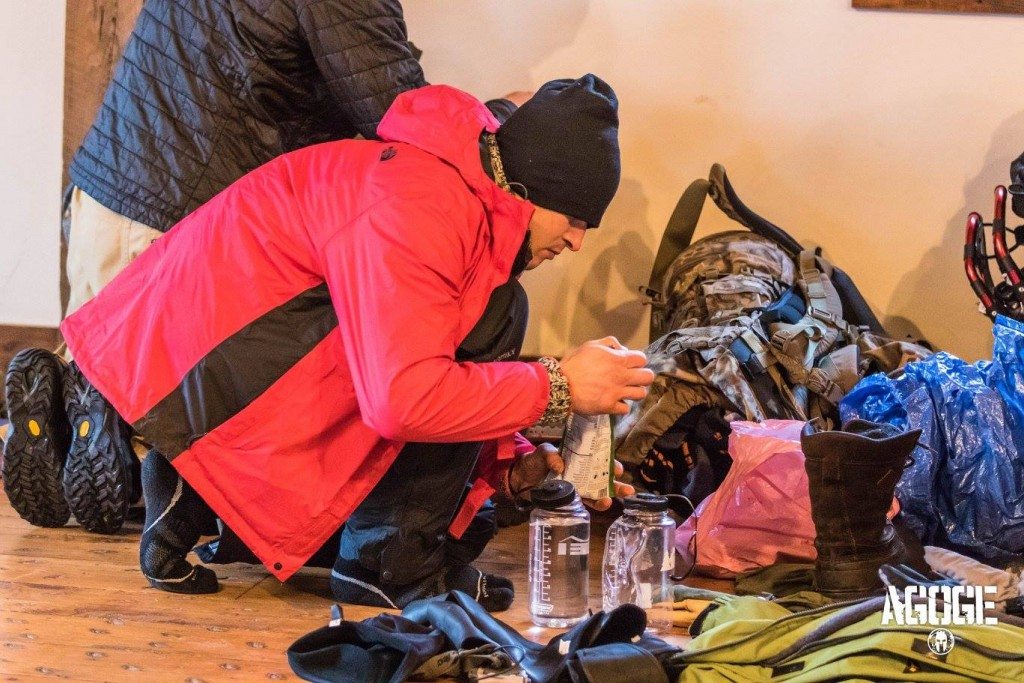
Along with the Ambronite, I ate Oatmega bars from Onnit, usually broken up and dropped in with my Ambronite for a bit of chunkiness and texture. I brought approximately 10,000 calories total: 10 packets of Ambronite and 20 Oatmega bars.
Warning: I definitely took a chance by bringing in my own food rather than the recommended MRE from the packing list sent out by Spartan. They could have easily taken away all my food and claimed that I did not pack what was specified on the packing list. However, due to a technical error, I got my packing list only a couple of days before the event so I did not have time to hunt down the recommended 4800 calorie MRE's. My recommendation to you? Pack your own healthy fuel, but also show up with MRE's as a backup in case your healthy fuel gets taken away.
-1 Primaloft Sleeping Bag rated at -10 degree or lower
-1 Thermarest Ridge Rest Solar Sleeping Pad
-1 Woodland Camouflage Waterproof Bivouac Sac, size that will fit you, sleeping bag, pad and your boots
-1 tarp, 8′ x 8′ minimum, any style or type.
-1 pair boots, minimum zero degree rating, recommend a removable liner for drying (bring 2 pairs if you do not have removable liners). Here is a good list of brands on Amazon. I highly, highly recommend the removal liner and zero degree rating. Break 'em in!
-4 pairs wool or synthetic cold weather socks, with 4 pair of these lightweight sock liners.
-1 Knit cap, wool or synthetic
-1 Chaos -CTR Tempest Multi Tasker Pro Micro Fleece Balaclava with Windproof Face
-1 of any of these wraparound snow goggles
-1 set Coldpruf Premium Performance Layer, top and bottom
-1 set wool warmth layer like this, top and bottom
-1 set Primaloft insulation layer like this, top and bottom
-1 set North Face shell layer, top and bottom, water and wind resistant
-2 pairs gloves with removable “contact-type” liners – I recommend the GI Trigger Finger Cold Weather -brand
-1 pair cold weather mittens like this
–100 feet of 550 parachute cord
-1 fire starting kit
-1 of any of these lightweight backpacking knives
-1 MSR WhisperLite Universal Stove
-1 Princeton Tek Apex headlamp (bring spare batteries!)
-1 pair MSR Evo Snowshoes
-1 set of Kahtoola Micro spikes
-2 clear 1 liter Nalgene bottles
-2 Wet-Nap Hands and Face Cleansing Wipes
-1 pair Trekking poles, recommend adjustable type with snow baskets.
-25 feet of this one inch tube webbing
-3 of these chem light sticks
-1 SUUNTO M-3 G Compass
-1 black Sharpie Retractable Fine Point Permanent Markers
-1 Quick Tie Large Trash Bag
-2 3”x5” cards in a re-sealable ziploc bag
–Barometric Altimeter (I used this SUUNTO Ambit3 Peak)
And this all fit nicely into my Kifaru AMR bag, packed super tight and pretty as you please.
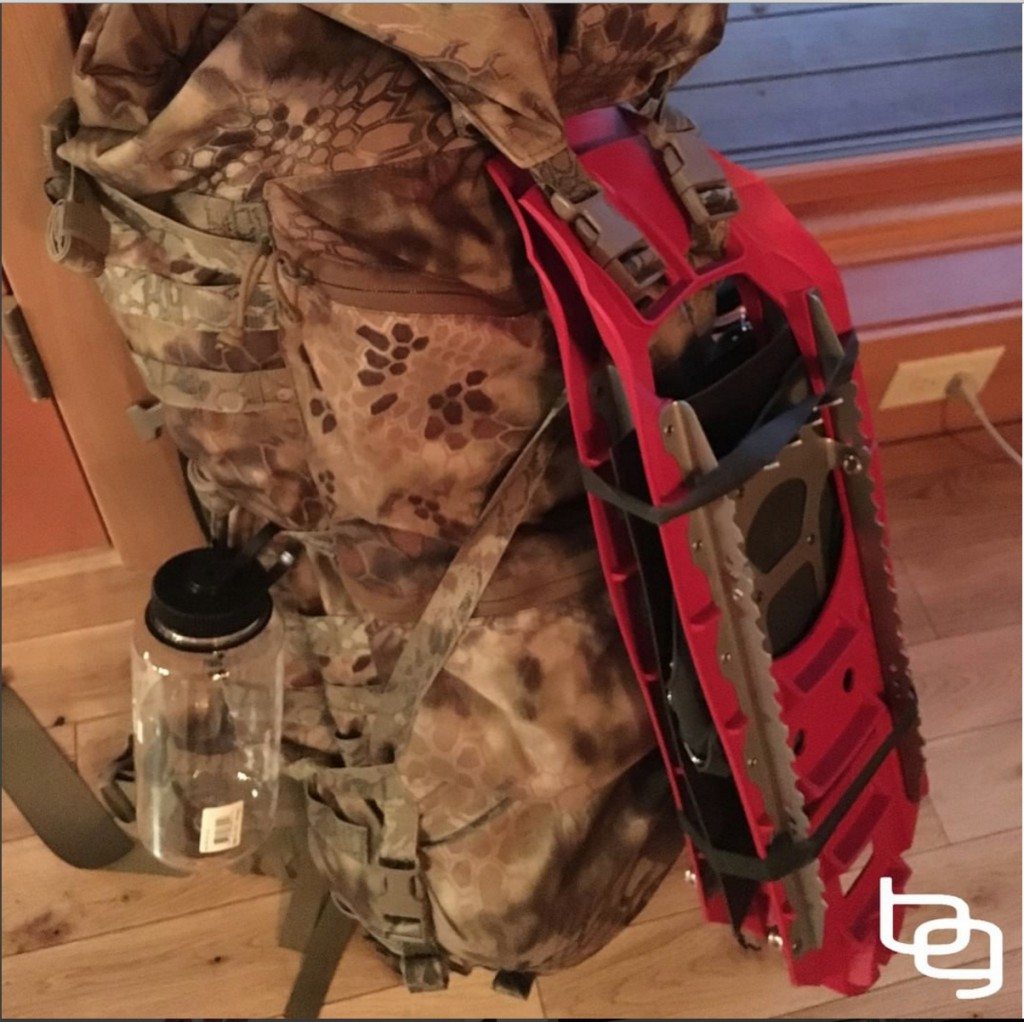
—————————–
Agoge Day 1
Okay, now that you know how to prepare and how to pack for the Spartan Agoge, let's jump into what to expect from the moment you show up.
First, let's get things clear: it was friggin' cold for Agoge 001. Below is the forecast the day before the event began. Once you add in the extreme wind that we wound up experiencing, temperatures actually dropped as low as 38° below zero. So put everything you're about to read, and the packing list above, in that context. Come prepared for the cold if you are doing the Winter Agoge.

Day 1 began with registration.
Don't be late for registration. I showed up 10 minutes before 6 AM, and I was glad I did. The folks who didn't read the instructions carefully, and instead showed up at 7:45 or 8 AM were definitely given a hard time.
Registration was pretty straightforward…we walked into the big brown barn, handed over our waivers, got checked out for about 10 minutes by a physician, and then headed outside into the frigid snow one-by-one for the gear check.
Here's how the gear check worked:
Step 1) Wander out into a snowy field with your bag, spread out your tarp, and lay all your gear out on the tarp.
Step 2) Stand there, freezing your ass off, while a staff member pours through your gear, makes sure that you have exactly what is required, and confiscates any gear that doesn't satisfy what is on the checklist.
Step 3) Put your gear back in your bag and head over to the initial beat down.
Below is a photo of a few folks out the middle of the field getting their gear checked.
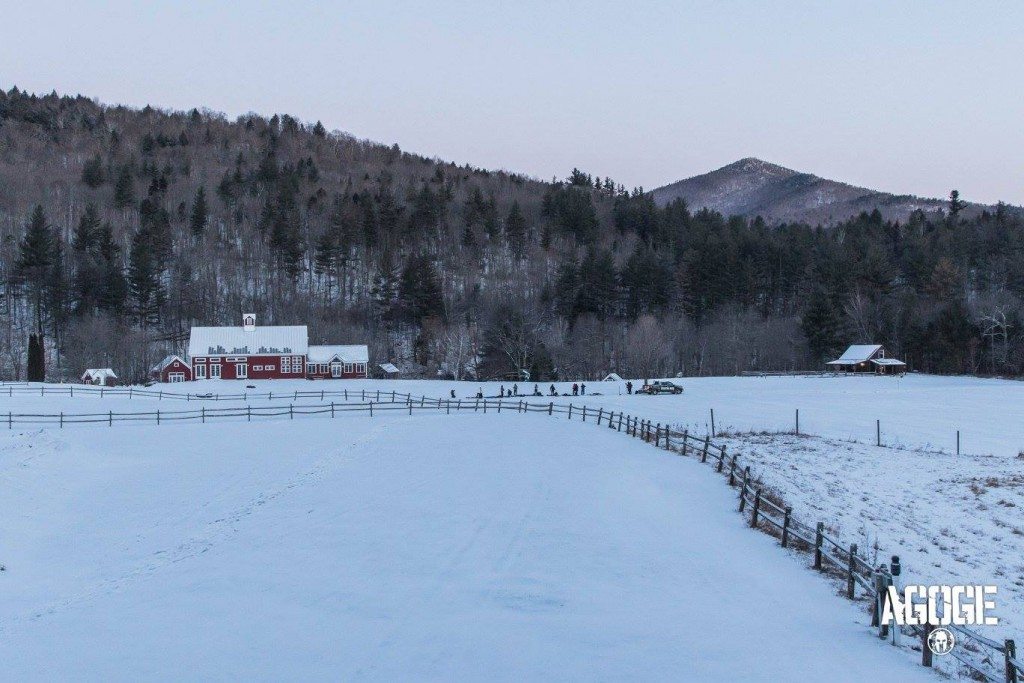
We then progressed into the initial beat-down. When I participated in the SEALFit Kokoro, the initial beat-down included things like getting cold water sprayed in your face from a high pressure hose, doing an ungodly number of burpees after being blindfolded and placed in an ice bath, getting demoralized by complete chaos and confusion from the Navy SEAL instructors, and performing calisthenics until you puked.
Don't expect anything more pleasant from the initial Agoge beat-down. For what seemed like hours, we were rolling in the snow, crawling in the snow, doing burpee broad jumps in the snow, doing hundreds of jumping jacks, panting through suicide runs, and pretty much getting worn to complete exhaustion while our teeth chattered from the cold.
Finally, when we were thoroughly exhausted, we got split into groups, just like the boat crews from the Shackleton expedition (in my opinion, you must read this book on Shackleton before attending Agoge), had all our packs and gear shuffled and mixed so that we were all caring for somebody else's pack and somebody else's gear, and finally assigned with our first big team task.
This first task involved placing hundreds of pounds of gear and rucks onto a wooden platform and then using our 25 feet of web tubing to figure out how to make that platform carryable by seven members of the team, while an eighth member of the team sat in the middle, nestled among the packs.
Needless to say, this whole set up turned out to be really, really heavy. Our team would literally take eight steps at a time, stop, rest, take another eight steps and continue to move at a snail's pace like this for hours.
As we navigated around the farm as a group, we stopped at specific stations along the way for 15 to 20 minute long educational sessions. Despite our extreme fatigue from caring hundreds of pounds of gear, along with an extra team member, this learning component was actually pretty cool.
We learned how to identify and manage hypothermia, how to build a shelter, how to build a fire, mental preparation skills, and of course, how to work together as a team. By the time we completed a full loop, I realized that the Agoge was going to be far more than just one big beat-down like, say, the Spartan Death Race – and was instead going to involve both education and teamwork along with grit and endurance development.

We then moved on to something that would be done literally dozens of times over the course of Friday, Saturday and Sunday: a foot check. This is exactly what it sounds like…everybody sits down on the ground, everybody takes off their boots, their socks, and their liners, and out of nowhere, like magical little elves, a medical team appears to inspect the feet and ensure that nobody is getting frostbite.
To me, it actually felt pretty good knowing that somebody was looking out for my precious appendages. If your feet were too white or too blue or you were showing any signs of frostbite and hypothermia, you would get pulled in the medical, warmed up, and then sent back out to the fray.
Not surprisingly, during those first few foot checks, a lot of people got pulled into medical. But it was pretty neat, over the course of the weekend, to see participants getting better and better at learning how to care for their feet and how to manage the cold. I'm personally far more confident after completing the Agoge about taking care of my own feet and hands during future events. And keeping my hands and feet warm during snowboarding is now going to be a piece of cake.
Here's a photo of one of the many foot checks.
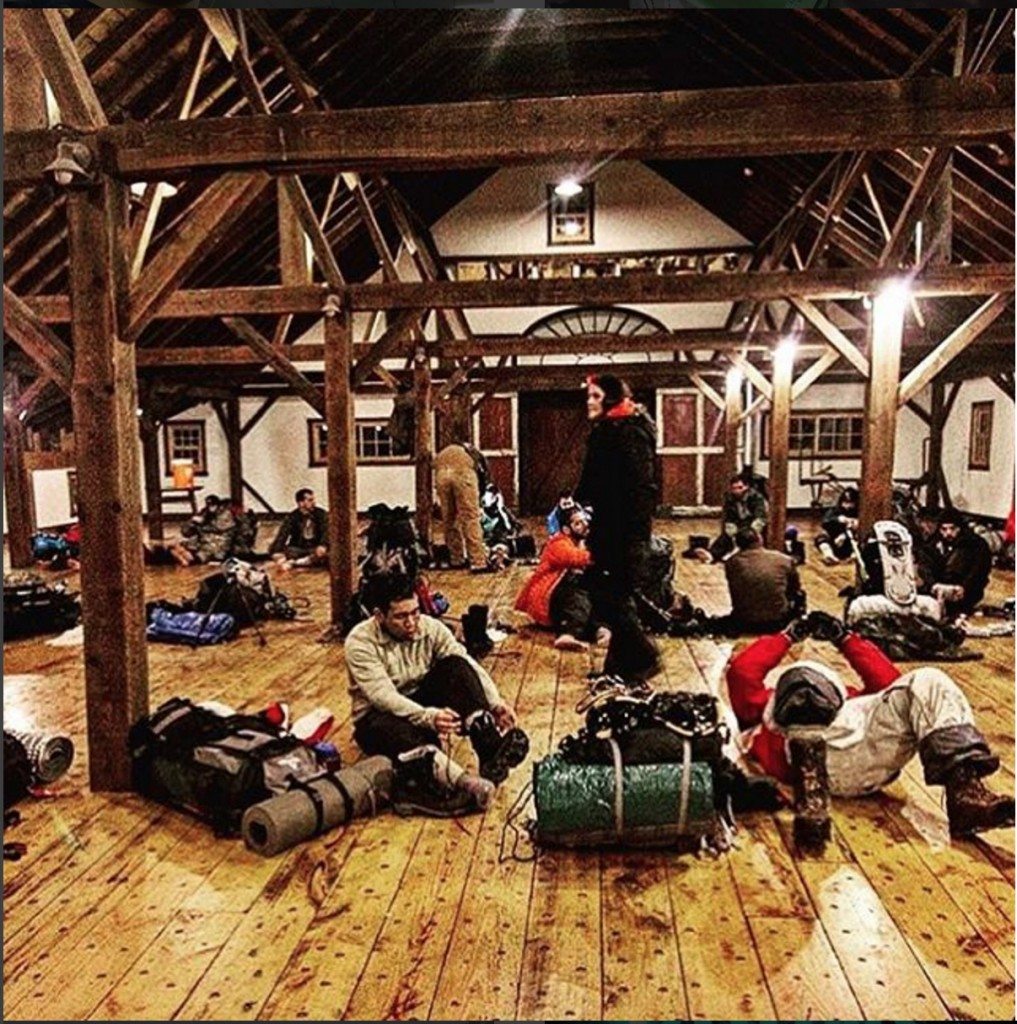
After the initial foot check we moved on to a very comprehensive hour-long course in compass, navigation, use of the altimeters, pace counting, and pretty much everything that we needed to know for the next evolution (“evolution” being the next event or challenge of the weekend). Once that course was finished, each team was given maps and navigation points, and sent out into the frigid, darkness for a night navigation challenge.

Once again, I was pretty happy to be able to combine my new orienteering skills with some pretty difficult rucking up and down the mountains around Pittsfield. The entire navigation course culminated with each team being sent out into the forest, close to midnight, to create shelters large enough to hold our entire team, fire making and firewood gathering, and setting up our sleep systems, including tarps, bivy sack, sleeping bag and air mattress, so that we would be able to survive through the frigid night outdoors.
As we created our shelters, there was a definite sense of urgency, for two reasons:
1) it was very cold, and the faster we collected firewood and used our tarps and para cord and web tubing to create our shelter, the faster we could get our fingers warm again;
2) there was an outside chance that we would actually get to sleep in the shelter once it was done. We were all keeping our fingers crossed that this would actually be the case.
By about 1 AM we had finished our shelter, and we designated one person from the team to watch the fire for one hour while the rest of us slept. That member of the team would then wake up the next person to tend the fire, and we would continue rotating like this until we were ripped from our slumber by the Agoge instructors.
But I didn't sleep a wink.
After having done Kokoro, in which there was zero sleep for 64 hours, and some pretty severe punishment if you actually did nod off, I went into the Agoge expecting the same. So even though I was able to crawl into my sleeping bag, I simply lay there awake, expecting some horrible punishment if I did actually fall asleep. Unfortunately for me, that's just the way I'm hardwired.
I began my fire tending shift at 3 AM. For an hour I added logs and kindling to the fire, which we had stacked rocks behind to allow more radiating heat to enter into our shelter.
At 4 AM, a team of instructors came charging through the forest with their headlamps, barking at us that we had exactly 30 minutes to completely deconstruct our shelter, tear down our campground and get back to the big red barn to prepare for the next evolution. And thus Day 1 ended and Day 2 commenced…
———————————
Agoge Day 2
To begin Day 2, my team, along with the three other teams that had been scattered throughout the forest that night, gathered in the big red barn for a foot check and to await further instructions. We were split into two groups, with each group comprised of two teams.
The first group was to get on a bus and be shuttled several miles away for an evolution comprised of navigation, repelling, fire making, hiking and rocking, and even memorization skills.
It turned out that I was in the first group, and I was glad. I've learned that in most of these type of events, if you are the first group to go experience some kind of an evolution, it typically means that whatever group is left behind is going to be engaged in some kind of a brutal sufferfest. Plus, I knew that, now that I realized there wasn't a punishment for sleeping, I might be able to actually get a little shut eye on this bus ride.
The 30 minutes of sleep that I got on the bus was indeed a perfect recharge, and as we pulled up to the edge of a frozen lake, I felt prepared to tackle Day 2. we were split back into teams. The first task given to my team was to figure out how to get all of our gear into a canoe and then to use our tube webbing to fashion handles and a pulling mechanism to drag the canoe across a frozen lake to a point that we were to navigate to using our compasses.
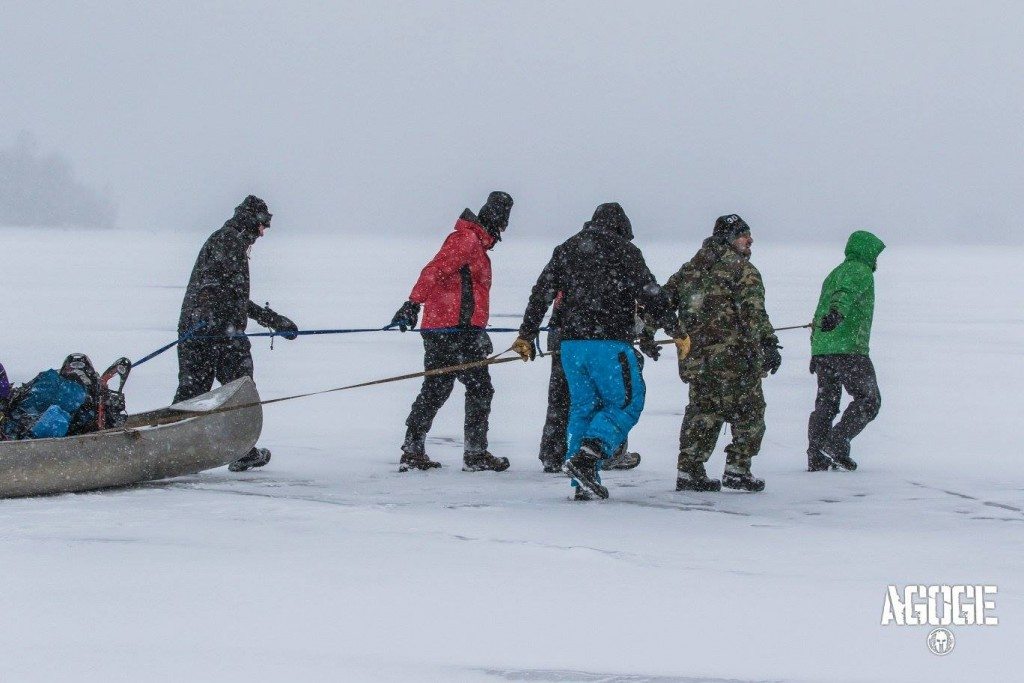
Several times, as we walked across the lake, there were loud cracks under the lake. I kept expecting to fall through the ice, but fortunately that never happened. We successfully brought the canoe to the target point and progressed to the next stage of the evolution, which was to climb a steep slope to rendezvous with a rappelling instructor, who was to teach us how to rappel off the wall of a series of cliffs and rocky crags covered in ice.
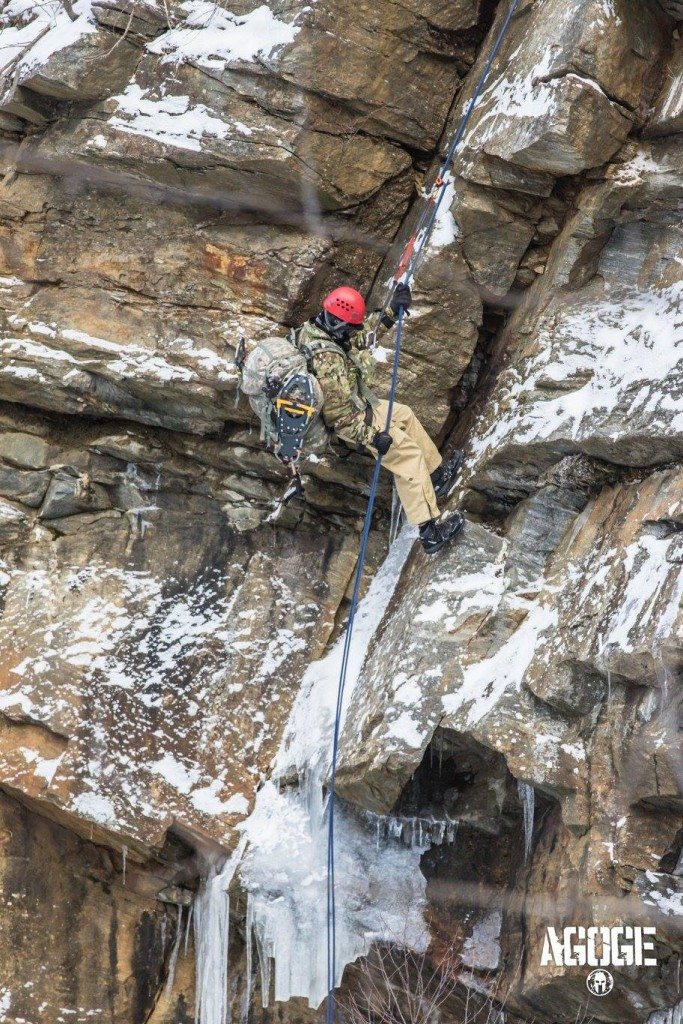
After rappelling down the cliffs, we arrived at a fire making station, where instructions were given to use the stoves that we brought to boil water from snow. After successfully completing this evolution, we were to use our map and compasses to navigate to a third part of the evolution, which was a fire making station, combined with a requirement to memorize a 12 stanza poem as a team. The penalty for failing to remember the poem was 10 burpees for each missed word. We were also given two minutes to generate a fire.
We split a few stanzas of the poem up among each member of our team, made a fire very quickly, successfully finished both these evolutions, and were finally cut loose to navigate our way back to the parking lot to rendezvous with the shuttle and be transported back to the farm. Once again, I caught a precious 20 minute catnap on the way back. Considering the shell-shocked look on the faces of the group that arrived to replace us as we departed the wilderness, I knew that something unpleasant was likely waiting for us back at the farm.
Sure enough, upon arriving back to the farm, we were immediately whisked off of the bus and marched to the brown barn. We were instructed to dress down to our base layer and to remove our shoes, our sock liners and our socks. The next four hours were probably some of the more mentally demanding hours of the entire event.
Long story short, we were forced to stand at attention for four hours. They turned off the heat in the brown barn. The floor was freezing cold. My feet slowly lost color and turned white. My entire body, by the third hour, was shaking and trembling from the cold. I simply stared out the window, engaged my body in deep box breathing, and tried to meditate my way through the entire thing. It turned out to be far more difficult than I expected to simply stand in the cold for four consecutive hours.
Finally, the second group arrived back from the wilderness, and we were all lined up to be given our next orders. At this point, I was a bit mentally exhausted, and even more physically exhausted than I thought I'd be after simply standing in one place for four hours.
By this time, the wind was howling and the temperature had dropped significantly. It was nearly 6 PM in the evening on the second day. Little did I know it, but this day was to be the coldest day that Vermont had experienced for the past 50 years, and we were about to spend the entire night out in the cold getting beat down with evolution after evolution.
The first evolution of this extremely long evening was a ski race, in which each member of the team had to figure out how to strap themselves to a couple of 2×6 wooden boards. Every member of the team except the person on the front of the skis and the back of the skis was blindfolded. We then had to figure out how to move as a group, picking up the skis one by one and moving at a snail's pace through an obstacle course that had been woven through the fields of the farm.
I am not kidding you: this evolution lasted for nearly four hours. Sometimes they made us reverse directions and go backwards. Sometimes they made us navigate around cones. If anyone fell off the skis or if anyone's feet touched the snow, the entire team had to go back to the beginning and start again. This entire revolution was, pardon the expression, a complete mind-f*&k.
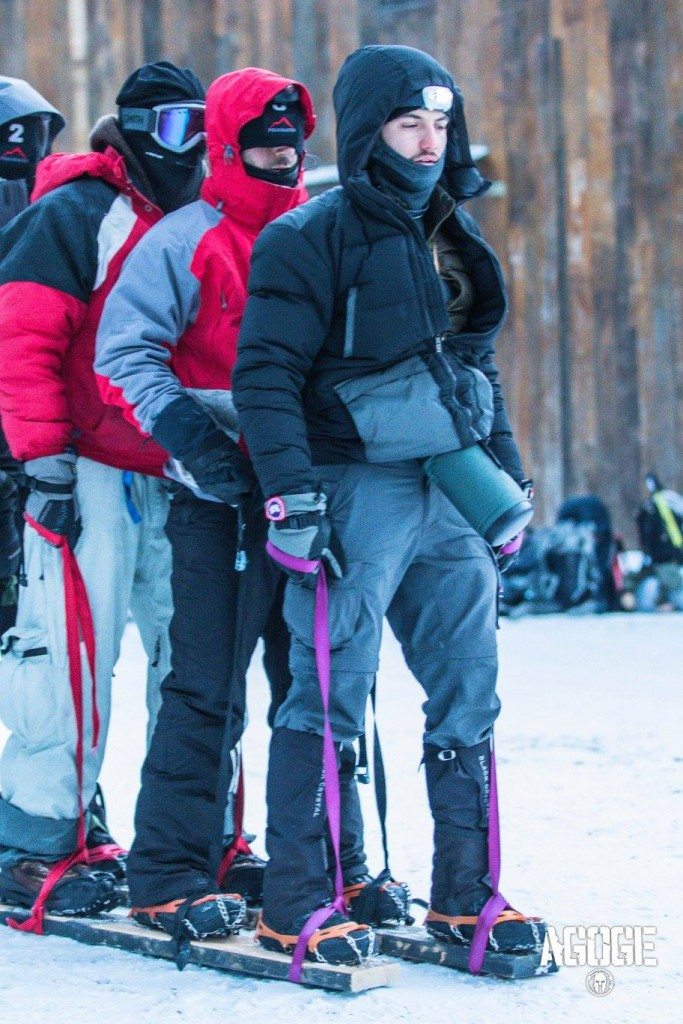
At close to midnight, freezing cold and exhausted, we finally finished the ski evolution and moved on to something that I considered to be slightly more pleasant. Nearly a dozen frozen fish were lined up in the snow, and each team was given the task of using firewood and rocks to build some kind of a mechanism to cook these fish and to get some calories into our cold bodies.
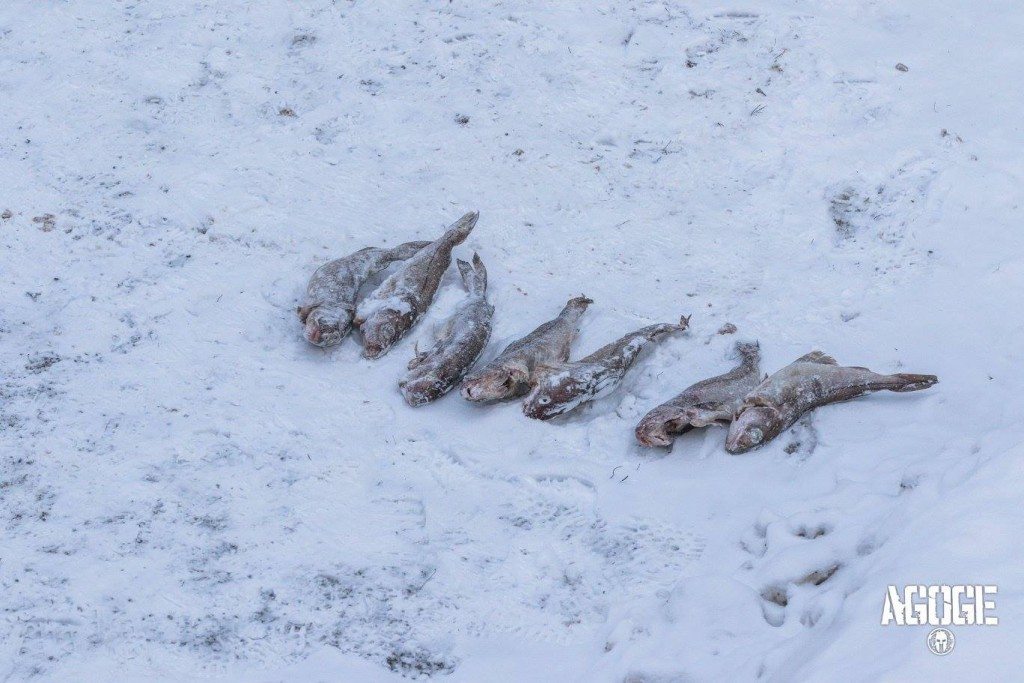
Each team was given a pot. One of the members of my team had filled his Nalgene bottle with Kool-aid, so our general plan was to fill the pot with Kool-Aid, heat the pot over the fire and cook the fish until it began to fall apart and we knew that it was cooked enough for us to actually eat, since by this time we were completely famished from the ski evolution.
Problem was, the weather was so freaking cold that it took nearly 20 minutes to even get much of a fire going. The pot was frozen solid. The fish was frozen solid. It took far longer than expected to actually figure out a way to boil the Kool-Aid and cook the fish in the Kool-Aid. But we did it: and I will admit, even in the absence of salt and pepper, this was one of the most satisfying meals I have consumed in a long, long time. Just plain old fish, cooked in Kool-Aid, and consumed at 38° below zero around 1 AM in the middle of a very difficult day.
We did not, however, have long to enjoy our fish. It was at this point in the evening that the Agoge instructors brought out a secret weapon: a special forces operative from Singapore, this paratrooper with extensive military experience who seem to specialize in being able to make one puke up the fish they had just eaten.
This guy had actually fashioned a quite evil evolution: an array of buckets filled with frozen ice that we as a team were to race with. Just imagine the bucket brigade in a Spartan race, and then freeze the buckets, and force yourself to do a series of ladder suicide runs, sprints, burpees, carries, partner hand-offs and hiking with heavy buckets. That was pretty much how this next evolution went for two hours. Of the entire Agoge, this was about the most anaerobic, physically demanding component. It probably didn't help that, once again, this was the coldest night on record in Vermont for 50 years, and here we were, racing through fields carrying frozen buckets.

After what seemed like hours, with multiple participants getting pulled into medical for extreme cold, and nearly everyone being on the verge of hypothermia for hours, we were finally marched back down to the big red barn. By this time, it was nearly 4 AM. I wasn't quite sure I could take much more, but I knew that once the sun came up, we'd be close to finishing. At this point, I knew if I could stay warm and awake, I could make it.
And so Day 3 began…
———————————
Agoge Day 3
Frankly, Day 3 started off just a bit strangely.
Once we were all shuffled into the big red barn, I fully expected us to get thrust immediately into some kind of a brutal final beat-down.
But that didn't happen.
Instead, we were instructed to lay out our sleeping gear, climb inside our sleeping bags, and sleep. Now, if you happened to read my description of the final hours of SEALFit Kokoro, then you know that what they did at Kokoro was pull us into a room for an hour of hot yoga, followed by the yoga corpse pose, in which you are lying on your back in a full state of relaxation, trying to fight the urge to pass into a completely exhausted comatose state. And then, without warning, you get assaulted with bullhorns, icy cold water, physical and mental suffering and utter chaos and confusion for nearly 4 hours.
So when they told us to climb into our sleeping bags in these final hours of the Agoge, that's exactly what I expected. I figured they would give 20 minutes or so for everybody to doze off into a complete set of exhaustion, and then we'd be rudely interrupted by an onslaught of physical suffering and mental breakdown.
Needless to say, with these expectations, I didn't sleep. I just lay there, listening for a door to open, listening for the footsteps of heavy boots to walk into the room, and just waiting for the final chaos to ensue.
A full two hours passed. The room was echoing with snoring and very loud fish farts. I truly believe that everyone except me fell asleep.
And then finally, just as I expected, I heard footsteps, and shortly after, a loud voice booming: “Everybody get up, NOW.”
Yep, it was time for the final beat down.
I'm going to be perfectly honest with you: maybe I was numb to the pain by this point, it wasn't actually that bad.
We didn't get thrown outside into the river that runs beside the farm. We didn't have to go outside in the snow in our underwear and roll around. We never even left the big red barn. Instead, as a group, we went through nearly 2 hours of everything from burpees, to flutter kicks, to hundreds of squats, to push-ups, to 10 minute plank holds, to just about every form of body weight exercise known to man. But there wasn't a great deal of actual demoralizing from the instructors. It was just more of a bit of a final attempt to drain every last little bit of energy out of our body before the Agoge was finished.
Again, since this was the coldest day on record in 50 years in Vermont, it's possible that whatever the powers that be originally had planned for us had to get canceled due to the extreme cold, and was instead replaced by a very, very long body weight workout.
Then, as we stood drenched in sweat and breathing in the body odor stench of three days of hard-core pushing, we were informed that we had officially completed Agoge 001.
It was over.
As these things usually go, it almost seemed a bit anti-climactic considering what we've been through the past three days. Once we picked our broken, sweaty bodies up off the floor of the big red barn, we were split into small groups to rehash our experiences, we had a final celebratory ceremony in which we received shirts and hoodies and medals and coins, and then, after plenty of hugging, fist pumping, and celebration, I think just about everybody wound up down at The General Store for a very big, hot breakfast.
I personally hitched a ride back to Boston and made an internal promise to myself that one of the very first things I was going to do was to hunt down a nice, hot sauna.
———————————
How To Recover From The Spartan Agoge
Let's finish with a few housekeeping items and some helpful advice, shall we?
First, I'm often asked…what exactly does one eat after finishing a brutal event like the multi-day Spartan Agoge?
Me, I want some plant-based antioxidants to fight off all the cellular damage that occurs from an event like this, so here is the Whole Foods bounty I brought back to my Boston hotel room and devoured before passing out for the night:
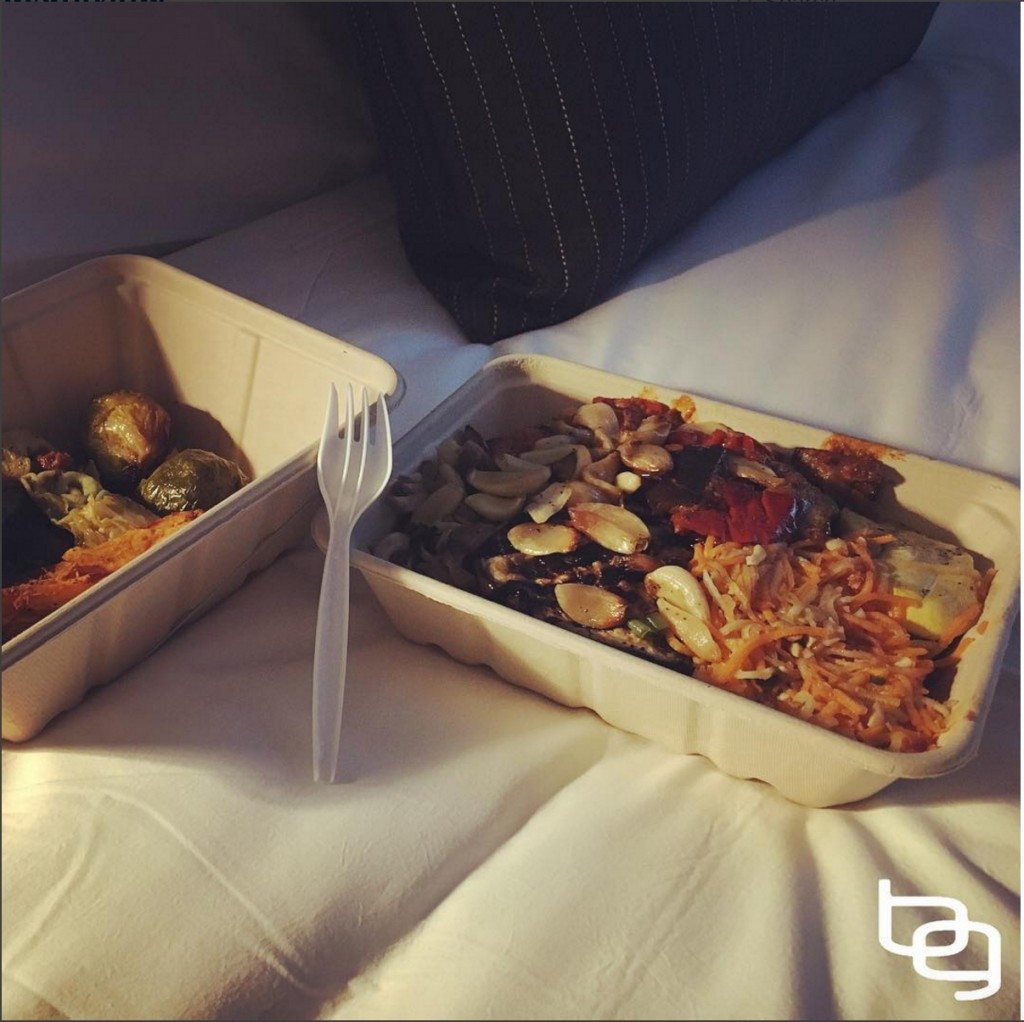
That's 34 bucks worth of goodies from the Whole Foods salad bar, and includes:
-Quinoa cakes
-Roasted Brussels sprouts
-Gluten-free tortellini with spinach
-Spring kale salad
-Roasted garlic
-Roasted eggplant
-Roasted peppers
-Roasted squash
-Fennel salad
-Sweet potato fries
And how about physical recovery?
The day after the Agoge, I posted on my Twitter that I was “looking for a gym”…and one reply was “Don't you take any days off?”
My response?
Active recovery rules.
So, what was my “active recovery” after the Agoge?
Before my flight home, I hit the Equinox gym in Boston for the following big recovery workout:
-30 minutes full body foam roller & mobility band
-5x 30 second hard/30 second easy Versaclimber
-5x 30 second hard/30 second easy elliptical
-5x 30 second hard/30 second easy rowing machine
-3 rounds of 15 dumbbell rows, 15 cable torso twists, 15 hex bar deadlifts, 15 upright rows (to hit gripping muscles without damaging many muscles used for the hiking/rucking/etc. in the Agoge)
-30 minutes hypoxic swim sets (as many rounds as possible of two laps breath hold underwater swimming with arms, two laps breath hold underwater swimming without arms, two laps freestyle swimming)
-30 minutes dry sauna yoga
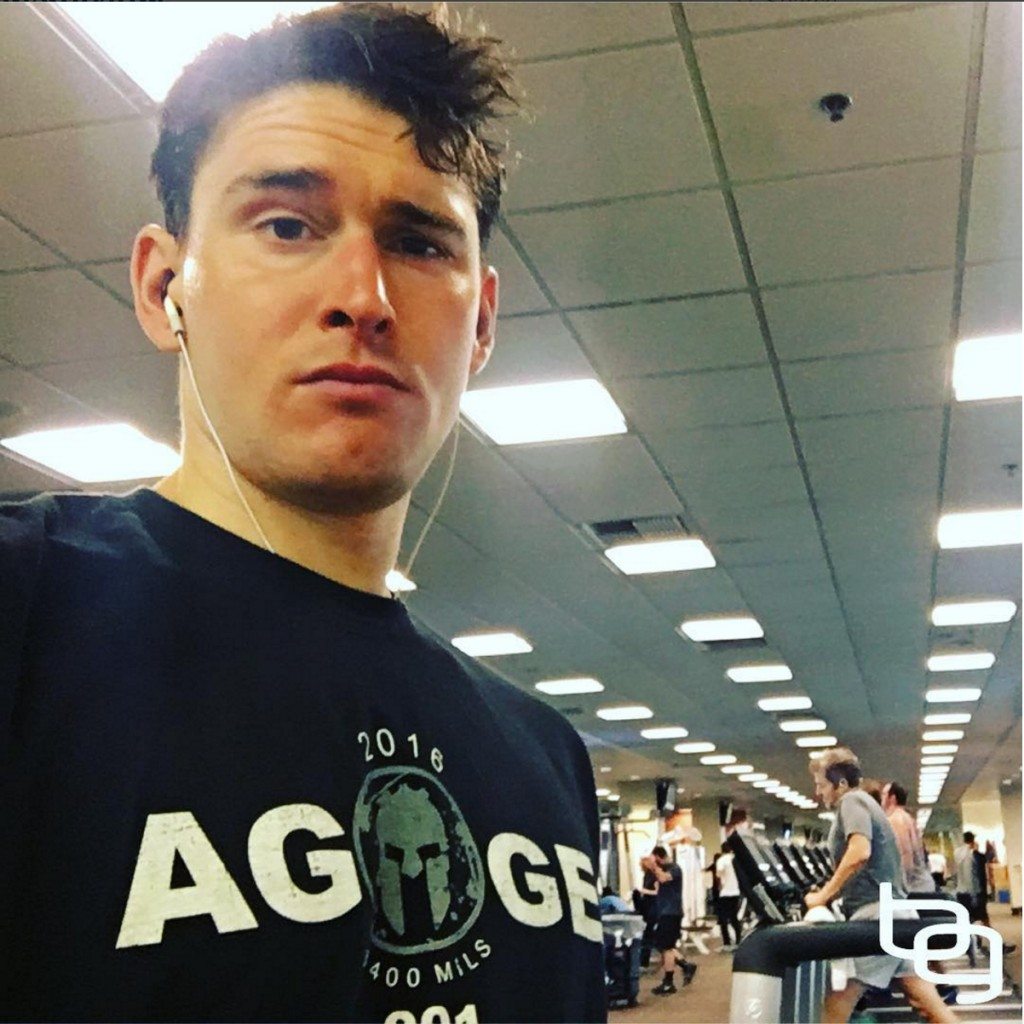
And I felt like a million bucks afterwards.
You'd be quite surprised at how much better you recover when you incorporate strategies such as eating plenty of nutrient dense, plant rich foods, sweating and moving your body in a large variety of ways after a brutal event like this, esecially compared to what you probably feel compelled to do, which would be to drink copious amounts of alcohol and lay around watching television.
I learned through years of Ironman racing and other big endurance events that the best way to recover is to simply keep moving and to resist the urge to binge on a bunch of booze and junk food. that's important for me. I really can't afford the time to get sick or to miss two weeks of workouts after an event like this, so I prioritize getting my body nursed back to health as fast as possible, and counter-intuitively, one of the best ways to do that is to start working out again right away, and to combine that with plenty of healthy foods.
———————————
Summary
So that's it. I'm happy to answer your questions and comments below.
If you dig these kind of events, then you should also check out my three part series on how to prepare for the famous SEALFit Kokoro camp, another similar crucible. Having a one-two Kokoro and Agoge under your belt would officially qualify you, in my humble opinion, as one of the toughest people on the face of the planet, with a damn impressive resume.
If you're still on the fence about all this, and perhaps feeling a bit of fear and an unsettling in your stomach about doing anything of this magnitude of endurance and grit, then I would encourage you to read one of my favorite quotes from Steven Pressfield's book “The War Of Art”.
“Are you paralyzed with fear?
That's a good sign.
Fear is good. Like self-doubt, fear is an indicator. Fear tells us what we have to do. Remember our rule of thumb: The more scared we are of a work or calling, the more sure we can be that we have to do it. Resistance is experienced as fear; the degree of fear equates to the strength of Resistance.
Therefore the more fear we feel about a specific enterprise, the more certain we can be that that enterprise is important to us and to the growth of our soul. That's why we feel so much Resistance. If it meant nothing to us, there'd be no Resistance.
Have you ever watched Inside the Actors Studio? The host, James Lipton, invariably asks his guests, “What factors make you decide to take a particular role?” The actor always answers: “Because I'm afraid of it.”
The professional tackles the project that will make him stretch. He takes on the assignment that will bear him into uncharted waters, compel him to explore unconscious parts of himself. Is he scared? Hell, yes. He's petrified. (Conversely, the professional turns down roles that he's done before. He's not afraid of them anymore. Why waste his time?)
So if you're paralyzed with fear, it's a good sign. It shows you what you have to do.“
I think that about sums it up, don't you?
If you're afraid of stuff like this, go sign up.
And leave your questions, comments and feedback about the Spartan Agoge below. I promise to help you out! If you want extremely personalized advice, you can click here to get a 20 to 60 minute phone Skype consult with me, or a training plan for this or any other event.
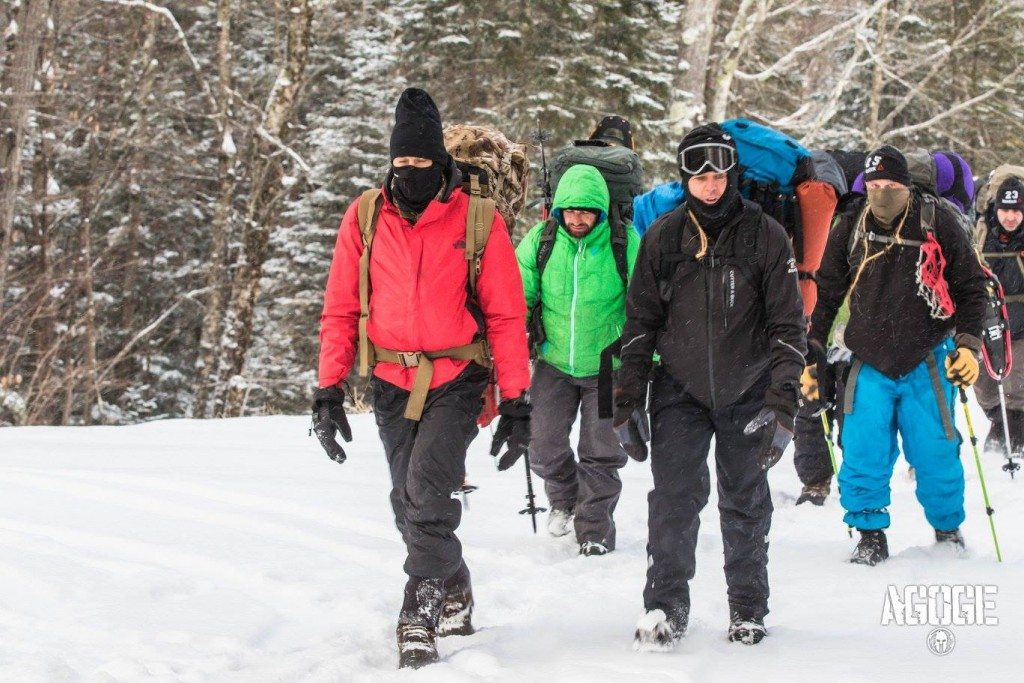

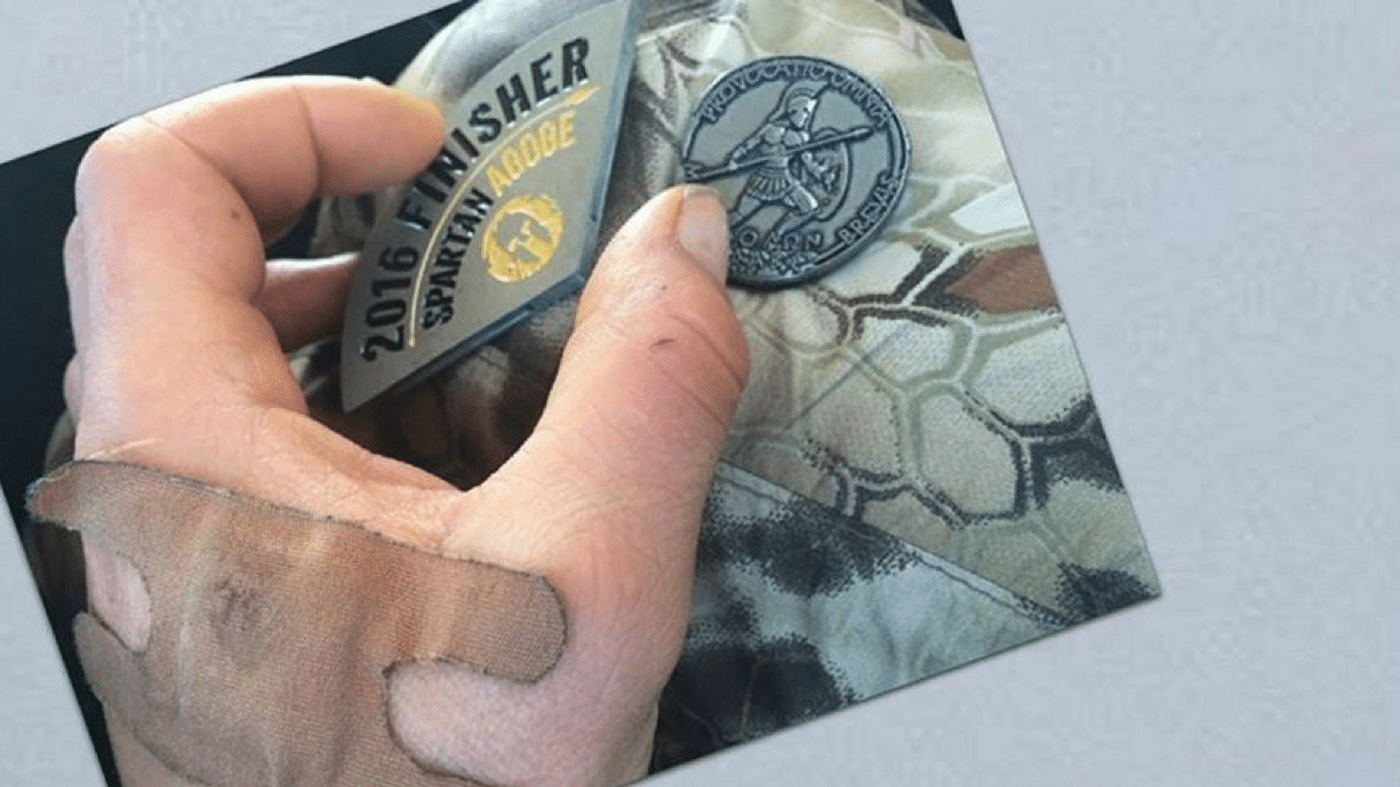





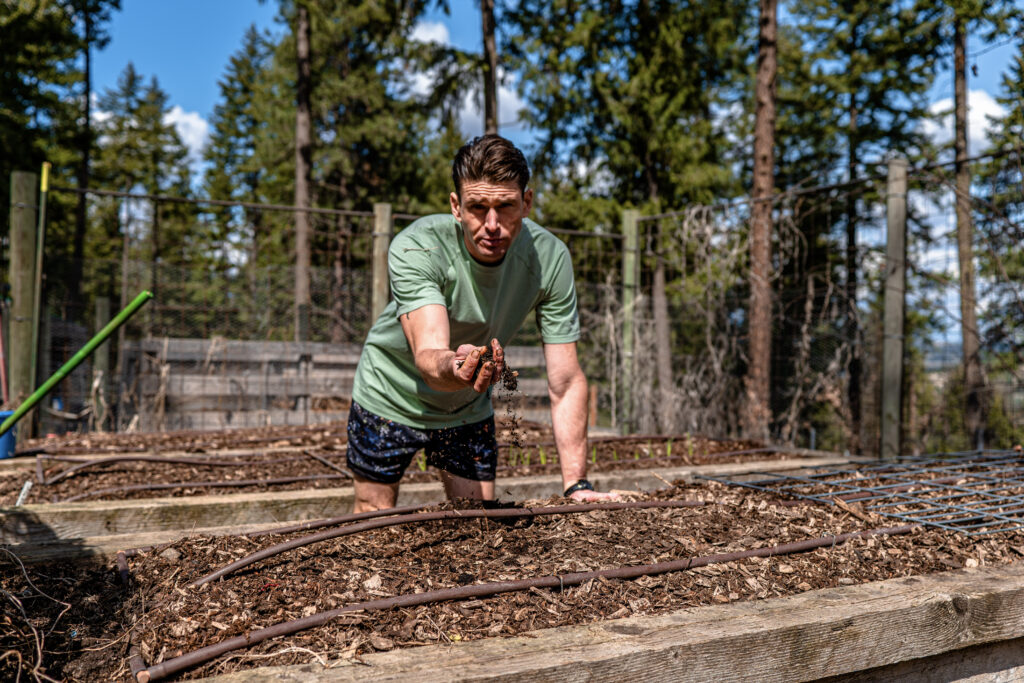






Hey Ben! Sounds painful! And here we go… I’m registered for the Summer Agoge and want To ask you about your camo Bivy… Do you think it would work fine for the Summer Agoge or is it too much? I was looking at some Outdoors Research Bivy as well but it’s over a hundred dollars more (lighter and smaller To pack tho)
Thanks in advance!
Check out the sleep systems at Kifaru.net. You save 15% with code BGF15 – lighter and smaller is fine for summer agoge I think.
Hey Ben, awesome input, I love these races that test grit, but I am doing the summer Agoge, any ideas on how it would be different from the winter one?
Yep, many. ;) I'd be happy to help you via a personal one-on-one consult. Just go to https://bengreenfieldfitness.com/coaching. and then choose a 20 or 60 minute consult, whichever you'd prefer. I can schedule ASAP after you get that.
Ben I’ve been reading/listening long since before we met at the Kona Championships thanks to our Timex friends, but like most people I’m too busy with my writing to remember to comment…this however deserves more time!
Each time you talked about this even I genuinely thought “holy hell’ and reading about it I was quite right, but what an amazing accomplishment. I can’t imagine what you learned about yourself and what it will propel you to do in the future!
Congrats!
Hi Ben, just signed up for the 2016 Summer AGOGE. Given that I’m travelling to the Pittsfield VT from Europe to take part, MRE’s aren’t easy to come by on this side of the pond. As I don’t have my gear list yet (one month before the event) I see myself scrambling to find stuff in the weeks leading up to the event. Given your list from the Winter AGOGE, I can confidently say that I already have most of the gear on hand, but I also imagine that the gear list for the Summer event will differ. However, my concern is getting my hands on the MRE’s. I could plan to arrive in the U.S. a few days earlier if there’s a place to pick up MRE’s and last minute supplies near the event. Cabala’s, REI or wherever you may recommend. Cheers in advance for your response.
REI will work, and Cabela's should have them too. Or you could always order from Amazon to whichever address you're planning on staying at and have it shipped there. Military surplus like this is best: https://amzn.to/2Clz6is
Thanks Ben, appreciate the feedback.
This may be a dumb sounding question, but what about bathroom breaks? Someone has to eventually hit the head. What if they really have to go, right in the middle of some multi-hour exercise, where one doesn’t know how long it will be?
We had bathroom breaks intermittently but in terms of the activities, but if it was a mutli hour exercise you just deal with it.
Roger that. Thank you.
Ben,
Congrats! You are a straight animal! So impressive. Thanks for the report, love reading this stuff. I’ve done the Killington Ultra Beast: I may have to look into the next Agoge! Not sure I could’ve handled the cold for this one (plus it’s wrestling season and I’m coaching), but those pictures were crazy. Keep it up and thanks for letting us peak behind the curtain.
Nice. Finally a well detailed report. Well done, Ben.
Ben – The agoge sounds intriguing except for the extreme cold parts. ;o) For your recovery, would you recommend a similar protocol for mere mortals running marathons (trail or road)?
Thanks!
Matt
I absolutely would. You should read my book at http://www.BeyondTrainingBook.com. a time more recovery techniques in there too. And marathon training plan.
Thanks, I’ll check it out.
Ben, there are a few books I keep close by and re-read, one is “Endurance Shackleton’s Incredible Voyage” who’s story you mentioned and another is “War on the Run” the story of Robert Rogers, I think you would enjoy it.
What do your consultation/coaching fees cost?
Just go to https://bengreenfieldfitness.com/coaching. – everything's there…
Hey Ben- great report. I’ve done a few expedition length (5-9 days) adventure races and am curious about the physical abilities of those in the Agogee? In AR, it’s not necessarily the fittest teams that do well. We’re you able to determine the fitness level of those in attendance? Would you say it’s more mental than physical? Curious.
Thx,
Ed
you know, the fitness level is not through the roof. I was a big part of it is more mental. At the same time, I say that you should be able to efficiently do a Spartan beast before you show up for something like this.
Hey Ben,mazel tov. Great job on the reporting of this event. Your thoroughness and focus is monumental.
You are crazy dude! Awesome!
What was the recommended MRE Spartan suggested?
Pretty much any cold weather MRE that had a ton of calories (4800)
Awesome report. I’ll have to re-read it again one of the next days. Been looking forward to some information from someone who actually did the Agoge.
One thing, for your gear list you use a lot of geni.us links, for me these just opened iTunes and … nothing. No links to podcasts, material or anything like it. Just iTunes :(
Maybe because I’m not using a US account but please do have a look at this and see if it can be solved.
hit refresh on your browser and try again. they worked fine for me!
Thanks Ben, works way better now. Some of the links do open in Amazon.de (probably due to my location) and does not show right items (if any at all). But most of them did work.
Keep up the good work.